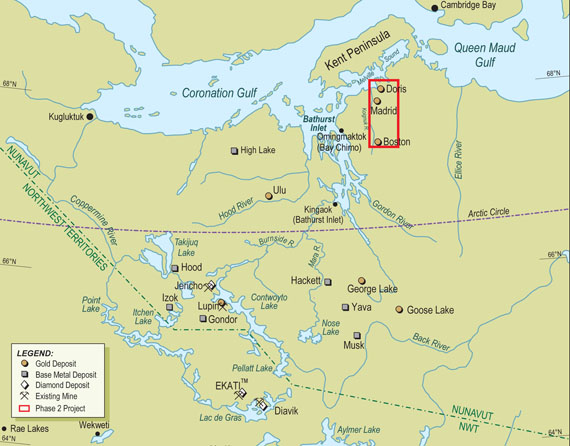A Nunavut gold miner’s expansion plans just cleared a big hurdle
In June the Nunavut Impact Review Board recommended that Canada's federal government approve the TMAC's plans to expand its operations at Hope Bay.

TMAC Resources Inc. has cleared a big milestone in its plans to develop three new underground gold mines in Nunavut’s Kitikmeot region.
On Tuesday, June 24, the Nunavut Impact Review Board recommended that the federal government approve the company’s plans to expand its operations at its Hope Bay property, about 150 kilometers southwest of Cambridge Bay.
TMAC has operated the Doris North gold mine at Hope Bay since early 2017, after scooping up the 1,600-square-kilometer property earlier from Newmont Mining Corp.
TMAC hopes to have mining operations underway at its Madrid North and Madrid South deposits by 2020, and at its Boston deposit by 2022.
The company estimates that Hope Bay holds 3.6 million ounces of proven and probable gold resources.
The new gold mines are expected to produce about 160,000 ounces of gold each year until at least 2032.

The company anticipates it will hire 70 people during the first year of construction, and up to 300 by the third year of construction. During operations, the company would employ about 800 people.
“This progress is in large part a testament to the proactive and diligent work by the Kitikmeot Inuit Association and our environmental affairs team during the NIRB process,” said Jason Neal, TMAC’s president and CEO, in a news release.
“We look forward to working with the Kitikmeot Inuit Association, Kitikmeot communities and government departments during the balance of the NIRB and [Nunavut Water Board] coordinated review process that is anticipated to provide TMAC with new project certificates later in 2018 and water licences in 2019.”
The impact review board stated in a news release that it heard widespread support for the project during public hearings held in Cambridge Bay in May.
However, it did hear concerns from residents about the project’s potential environmental impacts, including the potential impact on nearby caribou herds, the cumulative effects of shipping, the effects of discharging groundwater through a pipeline into nearby Roberts Bay, and the possibility of fuel spills.
To address these concerns, the board has recommended 54 measures to try to limit the environmental impacts of the project.
“The board is confident that if TMAC complies with the recommended terms and conditions, and builds on their experience and knowledge gained during the current operations at the Doris North gold mine, the project will yield lasting benefits to the residents of the Kitikmeot, Nunavut and Canada in general,” states a news release issued by the impact review board.
The company says it presently has three camps with significant infrastructure at Hope Bay, including a 1,000-tonne-per-day processing plant, air strips, roads, fuel storage, a port and power plants. New infrastructure that would be built includes additional camps and waste management facilities at Boston, and construction of an all-weather road to link the different sites at the property.
TMAC has signed an impact and benefit agreement with the Kitikmeot Inuit Association as the project sits mostly on Inuit-owned land controlled by the Kitikmeot Inuit Association and Nunavut Tunngavik Inc. The project is expected to generate about $400 million in royalties, mineral taxes and other payments.